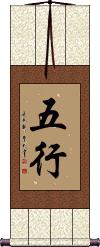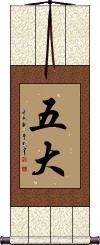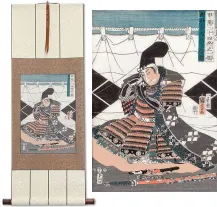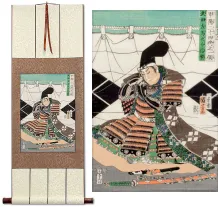Many custom options...
And formats...

The name Four Elements in Chinese / Japanese...
Buy a Four Elements calligraphy wall scroll here!
Personalize your custom “Four Elements” project by clicking the button next to your favorite “Four Elements” title below...
Five Elements Tai Chi Fist
五行太極拳 is a certain school or style of Tai Chi (Taiji).
The characters literally mean “Five Elements Tai Chi Fist.”
Notes:
In Taiwan, it would be Romanized as “Wu Hsing Tai Chi Chuan” - see the standard Mandarin method above in the gray box (used in mainland China and the official Romanization used by the Library of Congress).
The last three characters are sometimes translated as “Grand Ultimate Fist,” so the whole thing can be “Five Elements Grand Ultimate Fist” if you wish.
I have not confirmed the use of this title in Korean but if it is used, it's probably only by martial arts enthusiasts. The pronunciation is correct, as shown above for Korean.
Five Elements
五行 is the title of the five elements: wood, fire, water, earth, and metal.
The first character means five, and the second character is simply element(s).
According to ancient Chinese science, all matter in the world is comprised of these elements. One idea presented with the five elements is that when energy is added, the matter is believed to expand. When energy is removed, matter contracts. Oddly, this concept is not far from Einstein's theories and modern science. Just a few thousand years before Einstein.
More info: Wikipedia - Five Elements (Wu Xing).
See Also: Wood | Fire | Water | Earth | Metal | Five Elements
Five Elements
金木水火土 is a list of the Chinese characters for the five elements in a comfortable order (meaning that they “feel right” to a Chinese person who views this arrangement).
The order is metal, wood, water, fire, and earth.
Note that sometimes the metal element is translated as gold. And earth refers to soil versus the whole planet earth.
Five Elements
地水火風空 is the specifically-Japanese version of the five elements.
This is a little different than the ancient or original Chinese version.
The elements are written in this order:
1. Earth / Terra / Ground
2. Water
3. Fire
4. Wind / Air
5. Sky / Emptiness / Void / Ether
Note: This set of Kanji can also be romanized as “ji sui ka fuu kuu,” “jisuikafuukuu,” or “jisuikafuku.”
These can also be written in the order 地火風水空 (chi ka sui fuu kuu). Let me know when you place your order if you want the Kanji to be in this character order.
Four Elements
Buddhist Term
地水火風 is a Buddhist term that means “earth, water, fire, wind.”
This is often just referred to as “the four elements.” There is a more common title (the five elements) that adds wood to the mix. These four elements are used in some sects of Japanese Buddhism (not so much in Chinese).
Godai / Five Elements
五大 is the Japanese title for the five elements.
In Japan, the five elements differ slightly from the original Chinese. Therefore, in Japanese philosophy, you have earth, water, fire, wind, and void (space).
The meaning of the first character is 5, but the second character means great or large. Some translate this as the five majors. 大 is only understood as “elements” when you have 五 in front of it.
In Buddhism, this can be short for 五大明王, or the five great and wise kings.
This in-stock artwork might be what you are looking for, and ships right away...
Gallery Price: $72.00
Your Price: $39.88
Gallery Price: $108.00
Your Price: $59.88
Gallery Price: $108.00
Your Price: $59.88
Not the results for four elements that you were looking for?
Below are some entries from our dictionary that may match your four elements search...
| Characters If shown, 2nd row is Simp. Chinese |
Pronunciation Romanization |
Simple Dictionary Definition |
四大 see styles |
sì dà si4 da4 ssu ta shidai しだい |
More info & calligraphy: Shidai / Sida / Mahabhuta(1) {Buddh} the four elements (earth, water, fire, wind); (2) the human body; (3) Tao, heaven, earth and king mahābhūta, 四界; 四大界. The four elements of which all things are made; or the four realms; i. e. earth, water, fire, and wind (or air); they represent 堅, 濕, 煖, and 動 solid, liquid, heat, and motion; motion produces and maintains life. As 實 active or formative forces they are styled 四界 (四大界) ; as 假 passive or material objects they are 四大; but the 成實論 Satyasiddhi śāstra disputes the 實 and recognizes only the 假. |
地大 see styles |
dì dà di4 da4 ti ta chihiro ちひろ |
(personal name) Chihiro Earth as one of the 四大 four elements, 地 earth, 水大 water, 火大 fire, and 風大 air (i. e. air in motion, wind); to these 空大 space (Skt. ākāśa) is added to make the 五大 five elements; 識 vijñāna, perception to make the six elements; and 見 darśana, views, concepts, or reasonings to make the seven elements. The esoteric sect use the five fingers, beginning with the little finger, to symbolize the five elements. |
四大元無主 四大元无主 see styles |
sì dà yuán wú zhǔ si4 da4 yuan2 wu2 zhu3 ssu ta yüan wu chu shidai gan mushu |
The verse uttered by 肇法師 Zhao Fashi when facing death under the 姚秦 Yao Qin emperor, fourth century A. D.: — 'No master have the four elements, Unreal are the five skandhas, When my head meets the white blade, Twill be but slicing the spring wind. The 'four elements' are the physical body. |
四微 see styles |
sì wēi si4 wei1 ssu wei shimi |
The four minutest forms or atoms perceptible to the four senses of sight, smell, taste, or touch; from these arise the 四大 four elements, from which arise the 五智 five wisdoms, q. v. |
四蛇 see styles |
sì shé si4 she2 ssu she shida |
idem 四毒蛇. The Fanyimingyi under this heading gives the parable of a man who fled from the two bewildering forms of life and death, and climbed down a rope (of life) 命根, into the well of impermanence 無常, where two mice, night and day, gnawed the rattan rope; on the four sides four snakes 四蛇 sought to poison him, i. e. the 四大 or four elements of his physical nature); below were three dragons 三毒龍 breathing fire and trying to seize him. On looking up he saw that two 象 elephants (darkness and light) had come to the mouth of the well; he was in despair, when a bee flew by and dropped some honey (the five desires 五欲) into his mouth, which he ate and entirely forgot his peril. |
四執金剛 四执金刚 see styles |
sì zhí jīn gāng si4 zhi2 jin1 gang1 ssu chih chin kang shishū kongō |
The four Vajra-rulers of the four elements — earth, water, fire, wind, and of the S. E., S. W., N. W,. and N. E. |
四百四病 see styles |
sì bǎi sì bìng si4 bai3 si4 bing4 ssu pai ssu ping shihyakushibyou / shihyakushibyo しひゃくしびょう |
(yoji) {Buddh} every type of disease The 404 ailments of the body; each of the four elements— earth, water, fire, and wind — is responsible for 101; there are 202 fevers, or hot humours caused by earth and fire; and 202 chills or cold humours caused by water and wind; v. 智度論 65. |
非色 see styles |
fēi sè fei1 se4 fei se |
arūpa, formless, i.e. without rūpa, form, or shape, not composed of the four elements. Also the four skandhas, 非色四薀 excluding rūpa or form. |
四毒蛇 see styles |
sì dú shé si4 du2 she2 ssu tu she |
Four poisonous snakes (in a basket), e. g. the four elements, earth, water, fire, and air, of which a man is formed. |
毒蛇 see styles |
dú shé du2 she2 tu she dokuja; dokuhebi どくじゃ; どくへび |
More info & calligraphy: Viperpoisonous snake; poisonous serpent A poisonous snake.; Poisonous snakes, the four elements of the body— earth, water, fire, wind (or air)— which harm a man by their variation, i. e. increase and decrease. Also, gold. |
地水火風 地水火风 see styles |
dì shuǐ huǒ fēng di4 shui3 huo3 feng1 ti shui huo feng chisuikafuu; jisuikafuu / chisuikafu; jisuikafu ちすいかふう; じすいかふう |
More info & calligraphy: Four Elementsearth, water, fire, wind |
色 see styles |
shǎi shai3 shai shoku しょく |
(coll.) color; used in 色子[shai3 zi5] (counter) counter for colours; (female given name) Shiki rūpa, outward appearance, form, colour, matter, thing; the desirable, especially feminine attraction. It is defined as that which has resistance; or which changes and disappears, i. e. the phenomenal; also as 顯, 形 and 表色 colour and quality, form or the measurable, and mode or action. There are divisions of two, i. e. inner and outer, as the organs and objects of sense; also colour and form; of three, i. e. the visible object, e. g. colour, the invisible object, e. g. sound, the invisible and immaterial; of eleven, i. e. the five organs and five objects of sense and the immaterial object; of fourteen, the five organs and five objects of sense and the four elements, earth, water, fire, air. rūpa is one of the six bāhya-āyatana, the 六塵; also one of the five skandhas, 五蘊, i. e. the 色身. Keith refers to rūpa as 'material form or matter which is underived (no-utpādā) and which is derived (utpādā)', the underived or independent being the tangible; the derived or dependent being the senses, e. g. of hearing; most of their objects, e. g. sound; the qualities or faculties of feminity, masculinity, vitality; intimation by act and speech, space; qualities of matter, e. g. buoyancy and physical nutriment. |
五因 see styles |
wǔ yīn wu3 yin1 wu yin goin |
The five causes, v. 倶舍論 7. i. e. (1) 生因 producing cause; (2) 依因supporting cause; (3) 立因 upholding or establishing cause; (4) 持因 maintaining cause; (5) 養因 nourishing or strengthening cause. These all refer to the four elements, earth, water, fire, wind, for they are the causers or producers and maintainers of the infinite forms of nature. Another list from the Nirvana-Sutra 21 is (1) 生因 cause of rebirth, i. e. previous delusion; (2) 和合因 intermingling cause, i. e. good with good, bad with bad, neutral with neutral; (3) 住因 cause of abiding in the present condition, i. e. the self in its attachments; (4) 增長因 causes of development, e. g. food, clothing, etc.; (5) 遠因 remoter cause, the parental seed. |
六因 see styles |
liù yīn liu4 yin1 liu yin rokuin |
The six causations of the 六位 six stages of Bodhisattva development, q. v. Also, the sixfold division of causes of the Vaibhāṣikas (cf. Keith, 177-8); every phenomenon depends upon the union of 因 primary cause and 緣 conditional or environmental cause; and of the 因 there are six kinds: (1) 能作因 karaṇahetu, effective causes of two kinds: 與力因 empowering cause, as the earth empowers plant growth, and 不障因 non-resistant cause, as space does not resist, i. e. active and passive causes; (2) 倶有因 sahabhūhetu, co-operative causes, as the four elements 四大 in nature, not one of which can be omitted; (3) 同類因 sabhāgahetu, causes of the same kind as the effect, good producing good, etc.; (4) 相應因 saṃprayuktahetu, mutual responsive or associated causes, e. g. mind and mental conditions, subject with object; Keith gives 'faith and intelligence'; similar to (2); (5) 遍行因 sarvatragahetu, universal or omnipresent cause, i. e. of illusion, as of false views affecting every act; it resembles (3) but is confined to delusion; (6) 異熟因 vipākahetu, differental fruition, i. e. the effect different from the cause, as the hells are from evil deeds. |
地界 see styles |
dì jiè di4 jie4 ti chieh chikai ちかい |
boundary; bounds of the earth; (place-name) Jizakai The realm of earth, one of the four elements, v. 地大. |
水大 see styles |
shuǐ dà shui3 da4 shui ta suidai |
The element water, one of the four elements 四大 q. v. |
水界 see styles |
shuǐ jiè shui3 jie4 shui chieh suikai すいかい |
(1) (See 水圏) hydrosphere; (2) boundary of water and land; (place-name) Mizusakai The realm of water, one of the 四大 four elements. |
火大 see styles |
huǒ dà huo3 da4 huo ta kadai |
to get mad; to be very angry The element fire, one of the 四大 four elements. |
火界 see styles |
huǒ jiè huo3 jie4 huo chieh kakai |
The realm of fire, one of the realms of the four elements 四大, i. e. earth, water, fire, and wind. Cf. 火院. |
風大 风大 see styles |
fēng dà feng1 da4 feng ta |
Wind or air as one of the four elements. |
八變化 八变化 see styles |
bā biàn huà ba1 bian4 hua4 pa pien hua hachi henge |
Eight supernatural powers of transformation, characteristics of every Buddha: (1) to shrink self or others, or the world and all things to an atom; (2) to enlarge ditto to fill all space; (3) to make the same light as a feather; (4) to make the same any size or anywhere at will; (5) everywhere and in everything to be omnipotent; (6) to be anywhere at will, either by self-transportation, or bringing the destination to himself, etc; (7) to shake all things (in the six, or eighteen ways); (8) to be one or many and at will pass through the solid or through space, or through fire or water, or transform the four elements at will, e.g. turn earth into water. Also 八神變; 八自在. |
四大種 四大种 see styles |
sì dà zhǒng si4 da4 zhong3 ssu ta chung shi dai shu |
idem 四大. |
口力外道 see styles |
kǒu lì wài dào kou3 li4 wai4 dao4 k`ou li wai tao kou li wai tao kuriki gedō |
One of the eleven heretical sects of India. which is said to have compared the mouth to the great void out of which all things were produced. The great void produced the four elements, these produced herbs, and these in turn all the living; or more in detail the void produced wind, wind fire, fire warmth, warmth water, water congealed and formed earth which produced herbs, herbs cereals and life, hence life is food; ultimately all returns to the void, which is nirvana. |
唯境無識 唯境无识 see styles |
wéi jìng wú shì wei2 jing4 wu2 shi4 wei ching wu shih yuikyō mushiki |
Realism as opposed to 唯識無境 Idealism; implying that the four elements are real and permanent. |
四大不調 四大不调 see styles |
sì dà bù diào si4 da4 bu4 diao4 ssu ta pu tiao shidaifuchou / shidaifucho しだいふちょう |
{Buddh} falling ill (esp. of a monk); illness The inharmonious working of the four elements in the body, which causes the 440 ailments; cf. 四蛇. |
四大皆空 see styles |
sì dà jiē kōng si4 da4 jie1 kong1 ssu ta chieh k`ung ssu ta chieh kung |
lit. the four elements are vanity (idiom); this world is an illusion |
地 see styles |
dì di4 ti chi ち |
More info & calligraphy: Earth(n,n-suf) (1) earth; ground; land; soil; (n,n-suf) (2) place; (n,n-suf) (3) territory; (n,n-suf) (4) (See 天地無用) bottom (of a package, book, etc.); (n,n-suf) (5) (See 五大・1,土・ど・2) earth (one of the five elements); (surname) Hamaji pṛthivī, 鉢里體尾 the earth, ground; bhūmi, 歩弭 the earth, place, situation; talima, 託史麽 (or 託吏麽) ground, site; explained by 土地 earth, ground; 能生 capable of producing; 所依 that on which things rely. It is also the spiritual rank, position, or character attained by a Bodhisattva as a result of 住 remaining and developing in a given state in order to attain this 地 rank; v. 十住; 住位 and 十地. |
木 see styles |
mù mu4 mu moku もく |
More info & calligraphy: Wood(1) (abbreviation) (See 木曜) Thursday; (2) (See 五行・1) wood (first of the five elements); (female given name) Moku Wood; a tree; kāṣṭha, a piece of wood, wood, timber. |
空 see styles |
kòng kong4 k`ung kung kuu / ku くう |
More info & calligraphy: Sky / Ether / Void / Emptiness / Unreality(1) empty air; sky; (2) {Buddh} shunyata (the lack of an immutable intrinsic nature within any phenomenon); emptiness; (3) (abbreviation) (See 空軍) air force; (noun or adjectival noun) (4) fruitlessness; meaninglessness; (noun or adjectival noun) (5) (See 五大・1) void (one of the five elements); (can be adjective with の) (6) {math} empty (e.g. set); (female given name) Ron śūnya, empty, void, hollow, vacant, nonexistent. śūnyatā, 舜若多, vacuity, voidness, emptiness, non-existence, immateriality, perhaps spirituality, unreality, the false or illusory nature of all existence, the seeming 假 being unreal. The doctrine that all phenomena and the ego have no reality, but are composed of a certain number of skandhas or elements, which disintegrate. The void, the sky, space. The universal, the absolute, complete abstraction without relativity. There are classifications into 2, 3, 4, 6, 7, 11, 13, 16, and 18 categories. The doctrine is that all things are compounds, or unstable organisms, possessing no self-essence, i.e. are dependent, or caused, come into existence only to perish. The underlying reality, the principle of eternal relativity, or non-infinity, i.e. śūnya, permeates all phenomena making possible their evolution. From this doctrine the Yogācārya school developed the idea of the permanent reality, which is Essence of Mind, the unknowable noumenon behind all phenomena, the entity void of ideas and phenomena, neither matter nor mind, but the root of both. |
風 风 see styles |
fēng feng1 feng fuu / fu ふう |
More info & calligraphy: Wind(adj-na,n,n-suf) (1) method; manner; way; style; (adj-na,n,n-suf) (2) appearance; air; (adj-na,n,n-suf) (3) tendency; (adj-na,n,n-suf) (4) (See 六義・1) folk song (genre of the Shi Jing); (adj-na,n,n-suf) (5) (See 五大・1) wind (one of the five elements); (female given name) Fuwari vāyu. Wind, air; rumour, repute; custom; temper, lust. |
Click here for more four elements results from our dictionary
The following table may be helpful for those studying Chinese or Japanese...
| Title | Characters | Romaji (Romanized Japanese) | Various forms of Romanized Chinese | |
| Five Elements Tai Chi Fist | 五行太極拳 五行太极拳 | go gyou tai kyoku ken gogyoutaikyokuken go gyo tai kyoku ken | wǔ xíng tài jí quán wu3 xing2 tai4 ji2 quan2 wu xing tai ji quan wuxingtaijiquan | wu hsing t`ai chi ch`üan wuhsingtaichichüan wu hsing tai chi chüan |
| Five Elements | 五行 | gogyou / gogyo | wǔ xíng / wu3 xing2 / wu xing / wuxing | wu hsing / wuhsing |
| Five Elements | 金木水火土 | jīn mù shuǐ huǒ tǔ jin1 mu4 shui3 huo3 tu3 jin mu shui huo tu jinmushuihuotu | chin mu shui huo t`u chinmushuihuotu chin mu shui huo tu |
|
| Five Elements | 地水火風空 地水火风空 | chi sui ka fuu kuu chisuikafuukuu chi sui ka fu ku | ||
| Four Elements | 地水火風 地水火风 | chisuikafuu chisuikafu | dì shuǐ huǒ fēng di4 shui3 huo3 feng1 di shui huo feng dishuihuofeng | ti shui huo feng tishuihuofeng |
| Godai Five Elements | 五大 | godai | wǔ dà / wu3 da4 / wu da / wuda | wu ta / wuta |
| In some entries above you will see that characters have different versions above and below a line. In these cases, the characters above the line are Traditional Chinese, while the ones below are Simplified Chinese. | ||||
Successful Chinese Character and Japanese Kanji calligraphy searches within the last few hours...













